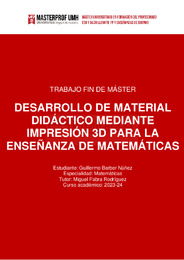Por favor, use este identificador para citar o enlazar este ítem:
https://hdl.handle.net/11000/32658Registro completo de metadatos
| Campo DC | Valor | Lengua/Idioma |
|---|---|---|
| dc.contributor.advisor | Fabra Rodríguez, Miguel | - |
| dc.contributor.author | Barber Núñez, Guillermo | - |
| dc.contributor.other | Departamentos de la UMH::Ciencias Sociales y Humanas | es_ES |
| dc.date.accessioned | 2024-07-23T12:23:29Z | - |
| dc.date.available | 2024-07-23T12:23:29Z | - |
| dc.date.created | 2024-06 | - |
| dc.identifier.uri | https://hdl.handle.net/11000/32658 | - |
| dc.description | Especialidad: Matemáticas | es_ES |
| dc.description.abstract | ANTECEDENTES: La creación de material educativo tridimensional mediante tecnologías de impresión 3D, con el propósito de enriquecer la enseñanza, es un procedimiento cada vez más estudiado y con amplio potencial didáctico. OBJETIVOS: El objetivo principal de este trabajo es diseñar y fabricar recursos tangibles que faciliten la comprensión de conceptos matemáticos abstractos, promoviendo la interactividad y el aprendizaje práctico en el aula. MÉTODO: Para ello, se ha llevado a cabo un análisis que permita identificar con precisión los conceptos matemáticos que presentan dificultades significativas para los estudiantes en aquellos bloques que sean más susceptibles de entender mediante material tangible. Usando esa información como base, el siguiente paso ha consistido en el diseño y desarrollo de modelos tridimensionales educativos centrados en estos conceptos específicos, asegurando su relevancia y aplicabilidad en el contexto educativo mediante una situación de aprendizaje. RESULTADOS: Se han explorado estrategias efectivas para la integración curricular de estos modelos tridimensionales, considerando la dinámica de la enseñanza y el tiempo de clase. Para implementar de manera específica el estudio realizado, se ha elegido centrar la situación de aprendizaje en el sentido geométrico para 2º de la ESO. DISCUSIÓN Y CONCLUSIONES: El uso de recursos didácticos tangibles es fundamental para mejorar el entendimiento de materias abstractas como las matemáticas. La impresión 3D es una tecnología que interesa a docentes y alumnos, creando un ambiente de motivación y aprendizaje en el aula. Además, su uso permite realizar trabajos multidisciplinares, así como el enfrentamiento a problemas reales del ámbito profesional | es_ES |
| dc.description.abstract | BACKGROUND: The creation of three-dimensional educational material using 3D printing technologies, with the purpose of enriching teaching, is a procedure that is increasingly studied and has significant didactic potential. OBJECTIVES: The main objective of this work is to design and manufacture tangible resources that facilitate the understanding of abstract mathematical concepts, promoting interactivity and practical learning in the classroom. METHOD: For this purpose, an analysis has been carried out to precisely identify the mathematical concepts that present significant difficulties for students in the blocks that are most likely to be understood through tangible material. Using this information as a basis, the next step involved the design and development of three-dimensional educational models focused on these specific concepts, ensuring their relevance and applicability in the educational context through a learning situation. RESULTS: Effective strategies for the curricular integration of these threedimensional models have been explored, considering the dynamics of teaching and class time. To specifically implement the study conducted, it was decided to focus the learning situation on geometric sense for 2nd-year secondary education students.DISCUSSION AND CONCLUSIONS: The use of tangible educational resources is fundamental for improving the understanding of abstract subjects such as mathematics. 3D printing is a technology that interests both teachers and students, creating an environment of motivation and learning in the classroom. Additionally, its use allows for multidisciplinary work and the tackling of real-world professional problems | es_ES |
| dc.format | application/pdf | es_ES |
| dc.format.extent | 36 | es_ES |
| dc.language.iso | spa | es_ES |
| dc.publisher | Universidad Miguel Hernández | es_ES |
| dc.rights | info:eu-repo/semantics/openAccess | es_ES |
| dc.rights | Attribution-NonCommercial-NoDerivatives 4.0 Internacional | * |
| dc.rights.uri | http://creativecommons.org/licenses/by-nc-nd/4.0/ | * |
| dc.subject | Innovación | es_ES |
| dc.subject | Didáctica | es_ES |
| dc.subject | Recurso tangible | es_ES |
| dc.subject | Situación de aprendizaje | es_ES |
| dc.subject | Educación | es_ES |
| dc.subject | TIC | es_ES |
| dc.subject | Impresión 3D | es_ES |
| dc.subject | FDM | es_ES |
| dc.subject.other | CDU::3 - Ciencias sociales::37 - Educación. Enseñanza. Formación. Tiempo libre | es_ES |
| dc.title | Desarrollo de material didáctico mediante impresión 3D para la enseñanza de matemáticas | es_ES |
| dc.type | info:eu-repo/semantics/masterThesis | es_ES |

Ver/Abrir:
TFM Barber Núñez, Guillermo.pdf
2,71 MB
Adobe PDF
Compartir:
 La licencia se describe como: Atribución-NonComercial-NoDerivada 4.0 Internacional.
La licencia se describe como: Atribución-NonComercial-NoDerivada 4.0 Internacional.
.png)